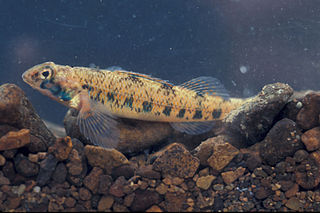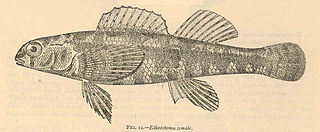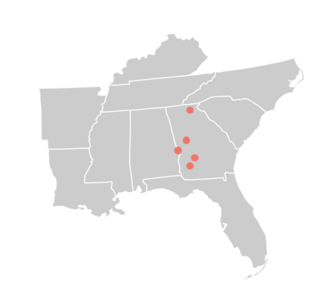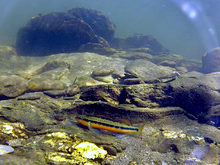
The snail darter is a small species of freshwater ray-finned fish, a darter from the subfamily Etheostomatinae, part of the family Percidae, which also contains the perches, ruffes and pikeperches. It is found in East Tennessee freshwater in the United States and in small portions of northern Alabama and Georgia. First recorded in 1973, the snail darter was listed as endangered under the U.S. Endangered Species Act of 1973 by 1975. The species was at the center of a major environmental law controversy that involved a lawsuit seeking to halt the completion of Tellico Dam, which posed a risk of extinction for the snail darter by blocking its migratory route. The case was eventually appealed to the U.S. Supreme Court, which ruled on it in its 1978 decision Tennessee Valley Authority v. Hill.

The leopard darter is a species of freshwater ray-finned fish, a darter from the subfamily Etheostomatinae, part of the family Percidae, which also contains the perches, ruffes and pikeperches. It is native to the United States, where it can be found only in the Little River drainage in Oklahoma and Arkansas. Its typical habitat is medium to large streams with rubble and boulder substrate. It feeds on small invertebrates on the riverbed and spawns mainly in March and April. It is threatened by impoundment, habitat loss and runoff from agricultural activities. It has never been a common species and has been listed as a threatened species in the United States since 1978, and the International Union for Conservation of Nature lists it as a "vulnerable species".

The amber darter is a small, endangered species of freshwater ray-finned fish, a darter from the subfamily Etheostomatinae, part of the family Percidae, which also contains the perches, ruffes and pikeperches. It is native to the Conasauga River and Etowah River in Georgia and Tennessee in the United States. It typically inhabits riffle areas over gravel and sand bottoms, hiding in aquatic vegetation when present. It feeds on small invertebrates and probably breeds between late fall and early spring. It is an uncommon fish with a small range and the International Union for Conservation of Nature has classified its conservation status as being "endangered".

The Roanoke logperch is a species of freshwater ray-finned fish, a darter from the subfamily Etheostomatinae, part of the family Percidae, which also contains the perches, ruffes and pikeperches. It is found in the Roanoke and Chowan drainages in Virginia and North Carolina in the United States. It inhabits low and moderate-gradient streams and rivers in warm, clear water in mostly unsilted gravel and rubble in runs, pools, and riffles. It is primarily insectivorous. This fish is a federally listed endangered species.
The Conasauga logperch is a species of freshwater ray-finned fish, a darter from the subfamily Etheostomatinae, part of the family Percidae, which also contains the perches, ruffes and pikeperches. It is endemic to the United States. It is one of 184 species of darters in North America. It has been listed as endangered throughout its range with critical habitat under the U.S. Endangered Species Act since August 5, 1985.

The dusky darter is a species of freshwater ray-finned fish, a darter from the subfamily Etheostomatinae, part of the family Percidae, which also contains the perches, ruffes and pikeperches. It is found in, but not confined to, both large and small rivers, and shallow creeks, in the eastern, southern, and southeastern United States, particularly the Mississippi River drainage system.

The blueside darter is usually found in the Tennessee River drainage in Tennessee, Alabama, North Carolina, and Virginia, and less commonly found in Bear Creek, Shoal Creek, and Barren Fork.

Etheostoma rufilineatum, the redline darter, is a species of freshwater ray-finned fish, a darter from the subfamily Etheostomatinae, part of the family Percidae, which also contains the perches, ruffes and pikeperches. It is endemic to the southeastern United States.

The snubnose darter is a species of freshwater ray-finned fish, a darter from the subfamily Etheostomatinae, part of the family Percidae, which also contains the perches, ruffes and pikeperches. It is endemic to the southeastern United States.

The orangethroat darter is a species of freshwater ray-finned fish, a darter from the subfamily Etheostomatinae, part of the family Percidae, which also contains the perches, ruffes and pikeperches. It is endemic to the central and eastern United States where it is native to parts of the Mississippi River Basin and Lake Erie Basin. Its typical habitat includes shallow gravel riffles in cooler streams and rocky runs and pools in headwaters, creeks, and small rivers, with sand, gravel, rubble, or rock substrates. It forages on the bottom for the aquatic larvae of midges, blackfly, mayfly and caddisfly, as well as isopods and amphipods. Spawning takes place in spring, the selected sites often being the upper stretches of riffles with sandy and gravelly bottoms interspersed with larger cobble. Reproductive success is high in this species. No particular threats have been identified, and the International Union for Conservation of Nature has assessed its conservation status as being of "least concern".

Etheostoma zonale, the banded darter, is a species of freshwater ray-finned fish, a darter from the subfamily Etheostomatinae, part of the family Percidae, which also contains the perches, ruffes and pikeperches. It is endemic to the eastern United States. It is mainly found in the Mississippi Basin, ranging from the Verdigris River in Kansas eastward to the Allegheny River in New York, and from the Minnesota River in Minnesota southward to the Ouachita River in Arkansas and the Tennessee River in Alabama. Its typical habitat in small and medium-sized rivers is riffles over cobble or gravel, rock slabs, and small boulders. It feeds on the riverbed on small insect larvae and is itself eaten by birds and larger fish. Males become more colorful and become territorial before spawning which takes place in spring. The females attach the eggs to waterweed. The population trend of this fish seems to be stable, it is a common species with numerous sub-populations over a wide range, no major threats have been identified and the International Union for Conservation of Nature has assessed its conservation status as being of "least concern".

The gilt darter is a species of freshwater ray-finned fish, a darter from the subfamily Etheostomatinae, part of the family Percidae, which also contains the perches, ruffes and pikeperches. It can be found in a number of states in the Mississippi River drainage of the United States although it has been extirpated from some river systems in which it was at one time present, mostly due to siltation and pollution problems. Males are more colorful than females and can grow to a length of about 9 cm (3.5 in). It is a benthic fish that feeds primarily on small aquatic insect larvae. Males form territories during the breeding season in late spring and early summer. Spawning typically takes place at the upper ends of riffles with sandy and gravelly bottoms interspersed with larger cobbles. Some organisations are endeavouring to conserve populations of the gilt darter and re-introduce it to states where the fish has been extirpated but suitable habitat still exists.
Percina kusha, the bridled darter, is a species of freshwater ray-finned fish, a darter from the subfamily Etheostomatinae, part of the family Percidae, which also contains the perches, ruffes and pikeperches. It is one of the 324 fish species found in Tennessee.

Percina maculata, the blackside darter, is a species of freshwater ray-finned fish, a darter from the subfamily Etheostomatinae, part of the family Percidae, which also contains the perches, ruffes and pikeperches. It is a widespread inhabitant of streams and rivers in the Mississippi River watershed. Like other darters it prefers rocky riffles and sandy runs, but is tolerant of pools and still water as well. It is one of the 324 fish species found in Tennessee.

The blackbanded darter is a species of freshwater ray-finned fish, a darter from the subfamily Etheostomatinae, part of the family Percidae, which also contains the perches, ruffes and pikeperches. It is native to the river systems of the southeastern United States where it is found in the states of Tennessee, Georgia, Florida, Mississippi, Alabama, and Louisiana. It lives over sandy or gravelly bottoms in smaller rivers and streams and its color varies depending on the different habitats in which it lives. It feeds on small insect larvae and is itself preyed on by larger fish. It spawns between February and June depending on locality. It is generally a common fish throughout most of its range.
Percina phoxocephala, the slenderhead darter, is a species of freshwater ray-finned fish, a darter from the subfamily Etheostomatinae, part of the family Percidae, which also contains the perches, ruffes and pikeperches. It is found in North America in the central Ohio and Mississippi River basins, to northeastern South Dakota and the Lake Winnebago system in Wisconsin, and as far south as the Red River in eastern Oklahoma and northeast Texas, typically in small to medium size rivers. It is a colorful species, with an average length of 6 to 9 centimeters. Males take on a deeper hue during the breeding season. It feeds on insect larvae and other small invertebrates, and spawns between April and June. It is a common fish with a very wide range and the International Union for Conservation of Nature has classified its conservation status as being of "least concern".
The olive darter is a species of freshwater ray-finned fish, a darter from the subfamily Etheostomatinae, part of the family Percidae, which also contains the perches, ruffes and pikeperches. It is native to Tennessee, Kentucky, North Carolina, and Georgia, in the United States. It is found in the headwaters of Tennessee River system and the middle reaches of the Cumberland River system, its ideal habitat being clear, cold water over rocky substrates. It grows to a length of about 5 in (13 cm) and is an insectivore, feeding mainly on insect larvae on the riverbed. The fish matures at age two and lives till about age four. Up to 1500 eggs are spawned which fall to the riverbed and get lodged among gravel. The olive darter is classified as a "vulnerable species", being affected by habitat destruction and siltation, often resulting from damming and impoundment of the rivers or the creation of weirs. It is also affected by the change in the forest riparian habitat resulting from the killing of trees by the hemlock woolly adelgid.
The frecklebelly darter is a species of freshwater ray-finned fish, a darter from the subfamily Etheostomatinae, part of the family Percidae, which also contains the perches, ruffes and pikeperches. It primarily occurs in the upper Kentucky and Green river systems of eastern and central Kentucky and north-central Tennessee, being found mostly in the Cumberland Plateau and Highland Rim regions. The fish gets its name from gets its name from the scattered dark spots on its relatively pale underside. However, a possible more telling characteristic of the species is the systematical arrangement of the spots at the base of the tail as well as the continuous stripes down either side of the back. Total population size is unknown but figured to be relatively large. The frecklebelly darter is a benthic darter that relies on invertebrates as its principal diet. The frecklebelly darter can be found primarily in creeks and small rivers with a moderate gradient and a pool/riffle type flow, and spends most of its time in midwater areas of the stream. The major threats of the frecklebelly darter include decimation through perturbations such as strip mining as well as stream channelization projects. The darter is thought to have a high resilience with minimum population doubling time less than 15 months; it is also believed to have low vulnerability. Frecklebelly darter females contain about 100-300 mature ova depending on size. Fish become mature by age 1. Spawning in this darter species involves egg burial where the male mounts the female and deposits eggs in deep depressions created by receptive females.
The saddleback darter is a species of freshwater ray-finned fish, a darter from the subfamily Etheostomatinae, part of the family Percidae, which also contains the perches, ruffes and pikeperches. It is native to the eastern United States. This darter species is widespread, occurring from the Escambia River drainage west to the Mississippi River basin and as far north as the Wabash River historically. Some populations have been reported in the Tennessee River drainage. The saddleback darter is aptly named as it has 5 saddle-like patterns on its dorsum, with the first occurring near the first dorsal fin and the fifth near the caudal penduncle. Adults can attain a maximum size of about 3 inches or 7.8 centimeters. The saddleback darter typically occurs over sand and gravel runs of creeks and small to medium-sized rivers and is sometimes found in very shallow water. This darter's diet consists of invertebrates such as caddisfly larvae, beetles, mayflies, and stoneflies. The saddleback darter deposits eggs over sand and gravel shoals during the spring. This species has an average lifespan between 2 and 3 years.

The Halloween darter is a small freshwater fish native to North America. It is found in Georgia and Alabama in the drainage basin of the Apalachicola River, specifically in the Flint River system and the Chattahoochee River system. It prefers shallow, fast-flowing areas with gravel bottoms in small and medium-sized rivers. It was first described in 2008, having not previously been distinguished from the Blackbanded darter (P. nigrofasciata), formerly thought to occur in the same watershed. Blackbanded darter has since been split again with Westfall's darter now recognised from the Apalachicola drainage. The species is somewhat variable, being generally blackish dorsally, with some individuals having indistinct saddle-like barring. Males have orange and dark lateral striping while females have dark stripes and a yellowish-green belly. At a maximum standard length of 101 mm (4 in), males are slightly larger than females, and both sexes develop distinctive orange barring on the edge of the first dorsal fin during the breeding season.















